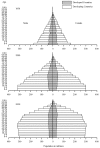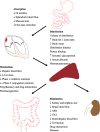Use of antiarrhythmic drugs in elderly patients
- PMID: 22783304
- PMCID: PMC3390066
- DOI: 10.3724/SP.J.1263.2011.00184
Use of antiarrhythmic drugs in elderly patients
Abstract
Human aging is a global issue with important implications for current and future incidence and prevalence of health conditions and disability. Cardiac arrhythmias, including atrial fibrillation, sudden cardiac death, and bradycardia requiring pacemaker placement, all increase exponentially after the age of 60. It is important to distinguish between the normal, physiological consequences of aging on cardiac electrophysiology and the abnormal, pathological alterations. The age-related cardiac changes include ventricular hypertrophy, senile amyloidosis, cardiac valvular degenerative changes and annular calcification, fibrous infiltration of the conduction system, and loss of natural pacemaker cells and these changes could have a profound effect on the development of arrhythmias. The age-related cardiac electrophysiological changes include up- and down-regulation of specific ion channel expression and intracellular Ca(2+) overload which promote the development of cardiac arrhythmias. As ion channels are the substrates of antiarrhythmic drugs, it follows that the pharmacokinetics and pharmacodynamics of these drugs will also change with age. Aging alters the absorption, distribution, metabolism, and elimination of antiarrhythmic drugs, so liver and kidney function must be monitored to avoid potential adverse drug effects, and antiarrhythmic dosing may need to be adjusted for age. Elderly patients are also more susceptible to the side effects of many antiarrhythmics, including bradycardia, orthostatic hypotension, urinary retention, and falls. Moreover, the choice of antiarrhythmic drugs in the elderly patient is frequently complicated by the presence of co-morbid conditions and by polypharmacy, and the astute physician must pay careful attention to potential drug-drug interactions. Finally, it is important to remember that the use of antiarrhythmic drugs in elderly patients must be individualized and tailored to each patient's physiology, disease processes, and medication regimen.
Keywords: aging; antiarrhythmic drugs; cardiac electrophysiology; ion channels; pharmacodynamics; pharmacokinetics; polypharmacy.
Figures


Similar articles
-
Is antiarrhythmic treatment in the elderly different? a review of the specific changes.Drugs Aging. 2011 Aug 1;28(8):617-33. doi: 10.2165/11591680-000000000-00000. Drugs Aging. 2011. PMID: 21812498 Review.
-
[Antiarrhythmic therapy in patients with heart failure].Ther Umsch. 2000 May;57(5):324-32. doi: 10.1024/0040-5930.57.5.324. Ther Umsch. 2000. PMID: 10859993 Review. German.
-
Hopes and disappointments with antiarrhythmic drugs.Int J Cardiol. 2017 Jun 15;237:71-74. doi: 10.1016/j.ijcard.2017.03.056. Epub 2017 Mar 16. Int J Cardiol. 2017. PMID: 28365182 Review.
-
Model systems for the discovery and development of antiarrhythmic drugs.Prog Biophys Mol Biol. 2008 Oct-Nov;98(2-3):328-39. doi: 10.1016/j.pbiomolbio.2008.10.009. Epub 2008 Nov 11. Prog Biophys Mol Biol. 2008. PMID: 19038282 Review.
-
Antiarrhythmic drugs in patients with implantable cardioverter-defibrillators.Am J Cardiovasc Drugs. 2005;5(6):371-8. doi: 10.2165/00129784-200505060-00004. Am J Cardiovasc Drugs. 2005. PMID: 16259525 Review.
Cited by
-
Efficacy Evaluation of the Mahuang-Fuzi-Xixin Decoction in Combination with Shenmai Injection for Bradyarrhythmia Treatment: A Systematic Review and Meta-Analysis.Evid Based Complement Alternat Med. 2023 Feb 4;2023:7280627. doi: 10.1155/2023/7280627. eCollection 2023. Evid Based Complement Alternat Med. 2023. PMID: 36785750 Free PMC article.
-
Relationship between seasonal weather changes, risk of dehydration, and incidence of severe bradyarrhythmias requiring urgent temporary transvenous cardiac pacing in an elderly population.Int J Biometeorol. 2014 Sep;58(7):1513-20. doi: 10.1007/s00484-013-0755-7. Epub 2013 Oct 22. Int J Biometeorol. 2014. PMID: 24146304
-
Efficacy, safety, and long-term survival of concomitant valve replacement and bipolar radiofrequency ablation in patients aged 70 years and older: a comparative study with propensity score matching from a single-Centre.J Cardiothorac Surg. 2020 Oct 2;15(1):291. doi: 10.1186/s13019-020-01322-9. J Cardiothorac Surg. 2020. PMID: 33008467 Free PMC article.
-
Interactions of Short-Term and Chronic Treadmill Training With Aging of the Left Ventricle of the Heart.J Gerontol A Biol Sci Med Sci. 2016 Aug;71(8):1005-13. doi: 10.1093/gerona/glv093. Epub 2015 Aug 5. J Gerontol A Biol Sci Med Sci. 2016. PMID: 26248561 Free PMC article.
-
Cardiac Arrest Following Treatment With Diltiazem for Atrial Fibrillation With Rapid Ventricular Response.Cureus. 2020 Nov 24;12(11):e11678. doi: 10.7759/cureus.11678. Cureus. 2020. PMID: 33391915 Free PMC article.
References
-
- Day JC. Population projections of the United States, by age, sex, race, and hispanic origin: 1993 to 2050. U.S. Bureau of the Census, U.S Government Printing Office, Current Population Reports; Washington DC: 1996. pp. 25–1130.
-
- DESA . World population prospect: The 2008 revision, population database. United Nations; New York: 2009.
-
- Mittelmark MB, Psaty BM, Rautaharju PM, et al. Prevalence of cardiovascular diseases among older adults. The Cardiovascular health study. Am J Epidemiol. 1993;137:311–317. - PubMed
-
- Bonow RO, Mann DL, Zipes DP, et al. Braunwald's Heart Disease: A textbook of cardiovascular medicine. 9th Edition. Saunders; 2011. Cardiovascular disease in the elderly; pp. 1727–1756.
-
- Fang MC, Chen J, Rich MW. Atrial fibrillation in the elderly. Am J Med. 2007;120:481–487. - PubMed
LinkOut - more resources
Full Text Sources
Research Materials
Miscellaneous
